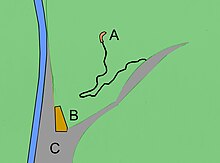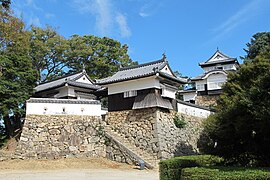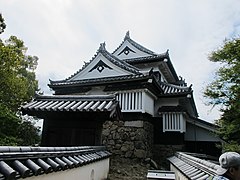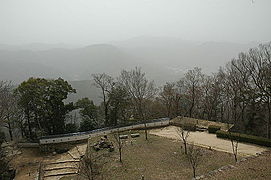Matsuyama Castle (Bitchu)
| Matsuyama-jō | |
|---|---|
|
Castle complex with the castle tower (back) |
|
| Alternative name (s): | Takahashi Castle |
| Creation time : | 1240 |
| Castle type : | Yamajiro (mountain castle) |
| Conservation status: | Castle tower, gate and walls (partially) preserved |
| Construction: | Stone, wood |
| Place: | Takahashi |
| Geographical location | 34 ° 48 '32.7 " N , 133 ° 37' 20.4" E |
The Matsuyama Castle ( Japanese 備中)松山城 , (Bitchū-Matsuyama-jō ), and Castle Takahashi ( 高梁城 , Takahashi-jō ) is a Japanese castle in Takahashi in Okayama Prefecture . As an important cultural asset of Japan, it has one of the 12 preserved castle towers in the country.
history
Akiha Shigenobu built a castle on the heights of the Gagyu ridge as early as 1240. At 480 m it is the highest castle that was maintained in the Edo period, although it was no longer used. The residence has been 1½ km away at the foot of the mountain since then.
After the Battle of Sekigahara , Kobori Masatsugi and son Masakazu, the latter better known as Kobori Enshū , received the castle as stewards (daikan) and began repairs from 1606, with the residence One-goya ( 御 根 小屋 ) at the foot of the mountain and above repaired the fortress on the heights. After the Ikeda took over the castle as daimyo with 65,000 koku in 1617 , the Mizunoya followed in 1642 with 50,000 koku. Mizunoya Katsumune expanded the castle in 1681, Mizunoya Sakyō-no-Sukekatsumune built the current castle tower in 1683. The Mizunoya carried the above family symbol, "Three left-turning Tomoe".
For a short time, Ōishi Kuranosuke acted as a representative at the castle, then the Andō took over the castle with 65,000 koku and Ishikawa (60,000 koku) until it fell to the Itakura in 1744 with an income of 50,000 koku. Towards the end of the Edo period took Lehnsfürst Itakura Katsukiyo (1843-1889), one of the Chancellor ( 老中 ) the Tokugawa government to the military conflicts of the Meiji Restoration in part, but time was in the Meiji further act such. B. by founding a bank.
To the castle complex
The Gagyū ridge consists of four peaks called Ōmatsuyama, Tenjin-no-maru, Komatsuyama, and Maeyama. The current castle complex is on Komatsuyama. The main castle has staircase-shaped outer castles in the north and south. Natural rock gradations are included. The castle tower also stands on rocks and is secured to the rear by a two-story watchtower.
photos
Remarks
literature
- Kato, Masafumi: Bitchu Matsuyama-jo in: Miura, Masayuki (ed.): Shiro to jinya. Saikoku-hen. Gakken, 2006. ISBN 978-4-05-604379-2 .
- 全国 城郭 管理者 協会 : 城 の し お り (Association of Castle Administrations : Bookmarks of Castles ), 2005.






